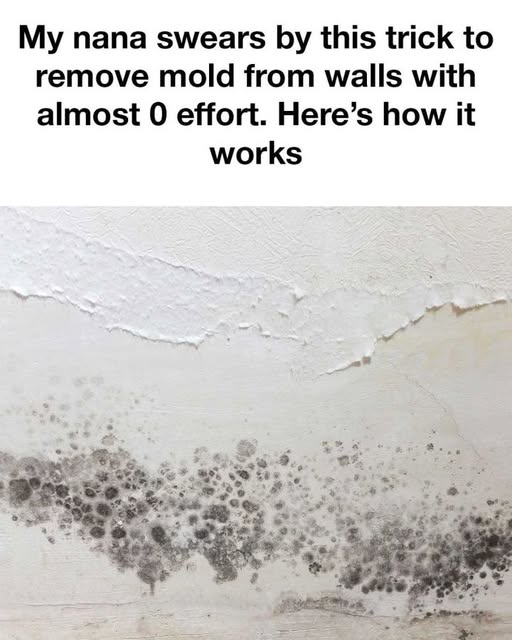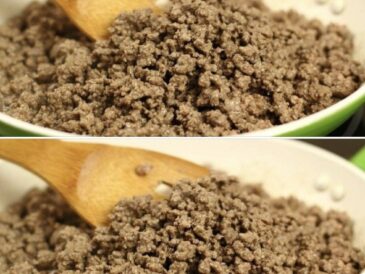Mold on walls is a common problem that can create both aesthetic and health-related issues in any home. While it’s known for being unsightly, mold also poses serious risks, particularly when it comes to health. People with allergies, asthma, and weakened immune systems are especially vulnerable to its harmful effects. As mold thrives in damp, humid environments, areas like bathrooms, kitchens, and basements are the prime targets for mold growth. The standard mold-removal methods usually require harsh chemicals, a lot of scrubbing, and a significant amount of time and energy. However, there’s a simple, almost effortless solution to mold removal, one that my Nana swears by. This method is effective, affordable, and easy, making it a game-changer for anyone dealing with mold on walls.
Why This DIY Mold Removal Trick Is a Game Changer
This mold-removal trick is different from traditional methods because it uses common household ingredients that are not only effective but also safe. Forget about expensive and harsh chemical cleaners; this method offers a cost-effective and environmentally friendly solution. Using ingredients you likely already have in your kitchen or cleaning supplies, you can remove mold from your walls with little effort. The beauty of this approach lies in its simplicity and efficacy—proving that sometimes, the easiest solutions are the best. Let’s take a closer look at how this method works and why it’s so effective.
Materials You Will Need for the Mold Removal Trick
The good news is that you don’t need to purchase any expensive or specialized products. The ingredients required for this mold-removal trick are common household items that are both affordable and easy to find. Here’s what you’ll need to get started:
- White vinegar – Known for its disinfectant properties, white vinegar is a natural cleaner that works wonders in breaking down mold and mildew.
- Baking soda – A versatile cleaning agent, baking soda helps to scrub away mold and can even neutralize odors that mold may leave behind.
- A spray bottle – For easy application of the cleaning solution.
- A microfiber cloth or sponge – Ideal for scrubbing and wiping away the loosened mold.
- A small bowl – For mixing the baking soda paste.
- Water – To dilute the vinegar if needed.
- Protective gloves – Optional, but it’s always better to protect your hands from any irritation caused by the vinegar or mold.
These materials are inexpensive and can be used for a variety of cleaning tasks around the house. With just a few simple steps, you’ll be able to get rid of mold without relying on harsh chemicals.
Step-by-Step Guide to Preparing Your Walls
Before applying your mold-removal solution, it’s important to prepare the affected area. The preparation process ensures that you are minimizing the risk of spreading mold spores and making the cleaning process more effective.
- Ventilate the Area – Open any windows and doors in the room to allow for proper ventilation. Mold spores can be harmful if inhaled, so it’s crucial to have fresh air circulating while you work. If the moldy area is particularly dry, lightly mist it with water using a spray bottle. This helps prevent the spores from becoming airborne as you clean.
- Wear Protective Gloves (Optional) – Though not mandatory, protective gloves are a good idea when dealing with mold and cleaning products. Gloves will protect your skin from any potential irritation caused by vinegar or mold.
- Prepare the Area – If the wall has accumulated significant mold growth, it’s best to clear any furniture or items that may obstruct your access to the affected area. Make sure the area is clean and ready for cleaning.
Applying the Mold Removal Solution
Once the area is prepped, you can begin creating your mold-removal solution. The process is simple and doesn’t require much effort.
1. Create the Vinegar Solution
The key ingredient in this mold-removal trick is white vinegar. Its natural acidity works as an effective disinfectant to break down the mold. You will want to create a diluted solution of vinegar and water. For standard mold removal, mix equal parts white vinegar and water in a spray bottle. Shake the bottle to combine the two ingredients, ensuring that the solution is well-mixed.
2. Spray the Affected Area
Generously spray the affected area with the vinegar solution. It’s important to ensure that the moldy surface is thoroughly saturated so the vinegar can start breaking down the mold. Allow the solution to sit on the wall for about an hour. This will give the vinegar enough time to penetrate the mold, loosening it from the surface and preventing regrowth.
3. For Stubborn Mold, Use Baking Soda Paste
If the mold is stubborn or deeply embedded into the surface, you may need a little extra help from baking soda. Baking soda is a mildly abrasive substance that can scrub away mold without damaging the wall’s surface. To create the paste, mix baking soda with a small amount of water in a bowl until you get a thick, paste-like consistency.
Apply this paste directly to the stubborn mold spots using a microfiber cloth or sponge. Gently rub the paste over the mold, ensuring it gets into every nook and cranny. Let the paste sit for about 15–20 minutes, which will help lift the mold off the wall. The natural scrubbing power of baking soda, along with the acidic vinegar, should be more than enough to break down the mold.
Safety Precautions to Keep in Mind
Even though this method uses natural ingredients, it’s still important to follow safety guidelines to protect yourself. While vinegar is relatively safe to handle, mold spores can be harmful if inhaled, and the cleaning process might stir them up. Keep the following safety tips in mind:
- Work in a Well-Ventilated Area – Always ensure that the area is well-ventilated to reduce the risk of inhaling mold spores or any fumes from the cleaning solution.
- Wear Gloves – If you have sensitive skin, it’s a good idea to wear gloves while cleaning. The vinegar may cause irritation for some people, so gloves will help protect your hands.
- Wear a Mask (Optional) – If you have respiratory issues or severe mold allergies, consider wearing a face mask to prevent inhaling mold spores during the cleaning process.
How Long to Let the Solution Sit
Allow the vinegar solution to sit for at least an hour. This provides the vinegar with enough time to work on the mold at its root level. For the baking soda paste, you only need to wait for 15 to 20 minutes for it to effectively lift the mold.
Wiping Down and Final Touches
After the vinegar has had time to work its magic, it’s time to scrub and clean the area. Use a clean microfiber cloth or sponge to gently scrub the affected area, wiping away the loosened mold. You might need to rinse the cloth or sponge periodically to avoid just spreading the mold around.
- Wipe the Area – After scrubbing, use a damp cloth to wipe away any residue. This will help ensure that no leftover vinegar or baking soda is left on the surface, which could attract more moisture.
- Repeat If Necessary – If you notice any stubborn spots of mold still present, you may need to repeat the process. Sometimes, mold can be tenacious, so a second round of treatment might be required.
Preventative Measures to Keep Mold from Returning
Once you’ve successfully removed the mold, it’s essential to take steps to prevent it from returning. Mold thrives in damp, humid conditions, so controlling moisture in the home is key. Here are some preventative measures you can take to keep your walls mold-free:
- Ventilate Your Home – Make sure areas prone to moisture, such as bathrooms and kitchens, are well-ventilated. Open windows, use exhaust fans, and consider installing a dehumidifier to control humidity levels in these areas.
- Use Mold-Resistant Paint – If you’re redecorating, consider using mold-resistant paint on your walls. This type of paint contains special additives that make it more difficult for mold to grow on painted surfaces.
- Regular Cleaning – Regularly clean and dry areas that are prone to moisture, such as the bathroom, kitchen, and basement. Drying wet surfaces immediately after use will help reduce the chances of mold developing in the first place.
Conclusion: A Hassle-Free Way to Mold-Free Walls
Mold on walls is a problem that can be tackled without a great deal of time, money, or effort. With this simple, foolproof mold removal trick using basic household ingredients like white vinegar and baking soda, you can easily eliminate mold from your walls. Not only is this method effective, but it’s also cost-efficient and safe. By taking a few simple steps to remove the mold and implementing preventative measures, you can ensure that your home stays mold-free in the future.
So, next time you’re faced with mold on your walls, remember that the solution might be right in your kitchen. Give this method a try, and discover just how easy mold removal can be!




